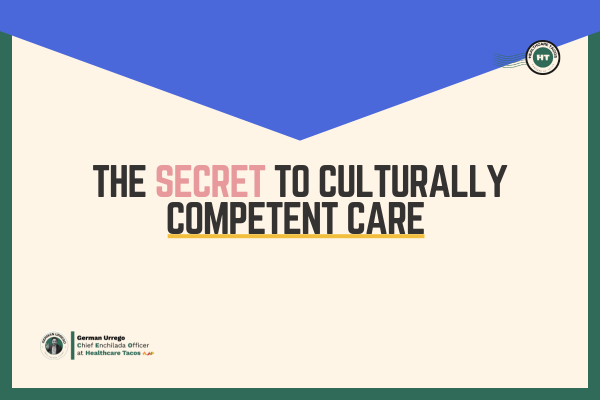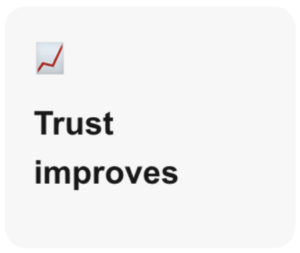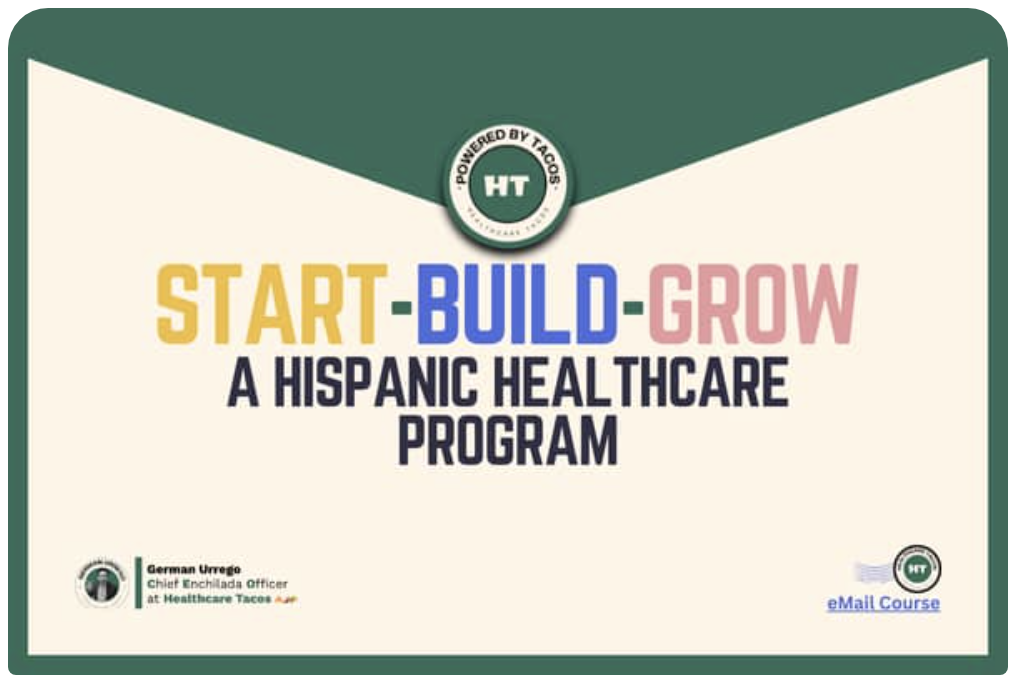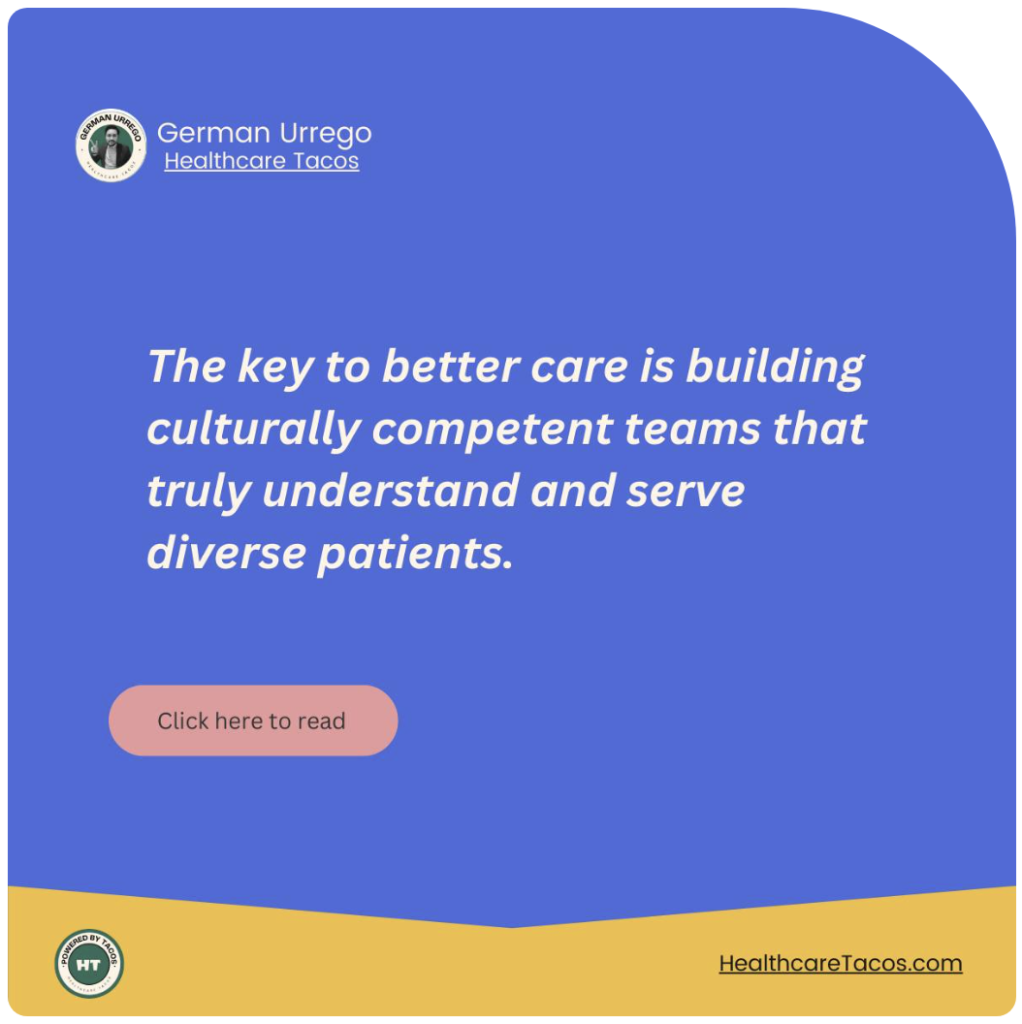

Amig@s – Let’s taco ‘bout Culturally Competent Care
Let’s be real.
Most healthcare workers are NOT trained to serve Hispanic patients effectively.
Not because they don’t care but because no one taught them how.
They’re given textbooks on anatomy, protocols for patient care, and endless compliance training.
Am I right, or am I right? – LOL
But where is the training on understanding the people they serve.
For Hispanic families.
This gap is not just frustrating; it’s dangerous, and it won’t change without proper training.
So today, I want to taco ‘bout this enchilada.
Amig@s – Let’s taco ‘bout Culturally Competent Care
Let’s be real.
Most healthcare workers are NOT trained to serve Hispanic patients effectively.
Not because they don’t care but because no one taught them how.
They’re given textbooks on anatomy, protocols for patient care, and endless compliance training.
Am I right, or am I right? – LOL
But where is the training on understanding the people they serve.
For Hispanic families.
This gap is not just frustrating; it’s dangerous, and it won’t change without proper training.
So today, I want to taco ‘bout this enchilada.
![]()
Three Insights 🌶️
I. Why Most Staff Isn’t Ready for Cultural Care
If you work in healthcare, which I know you do.
You’ve probably heard phrases like “Cultural competency matters” or “We value diversity.”
Great, but where in the world is the actual training?
Right?
Most healthcare organizations lack structured education on cultural care.
If they offer it at all, it’s a short module or a guest speaker.
Yes, I know, I’m right.
In other words, it’s something to check off the list, not a real learning experience.
The result?
→ Distrust
→ Missed diagnoses
→ Miscommunication
So, think about it.
A doctor might explain a treatment plan perfectly in Spanish.
Still, if they don’t understand that Abuela needs to talk it over with her family before deciding, they’ll mistake hesitation for noncompliance.
Now check this out.
A nurse might greet a Mexican patient warmly but unknowingly offend a Cuban patient by using the wrong term.
So here is the reality.
It’s not enough to “mean well.” Without real training, healthcare professionals will keep making mistakes that push Hispanic patients away.
So, what’s the fix?
We should work on it together to ensure it’s done right.
Get trained here with my FREE email course, Start, Build, Grow a Hispanic program.
II. Trust Is Built, Not Assumed
Hispanic patients are NOT just wary of the healthcare system; they’ve been failed by it.
→ A Cuban immigrant hesitates to seek care because of past medical abuse in their home country.
→ A pregnant Latina avoids prenatal visits because she’s been dismissed before.
→ A farmworker skips follow-ups because they can’t miss a shift without losing income.
These are NOT hypotheticals.
They’re real, daily barriers that my community faces.
And yet, most training programs do NOT mention them, even though they are the key to better care.
So, if you were to take something from this email, take this.
Culturally competent care isn’t about memorizing customs but recognizing lived experiences.
Therefore, please train your staff to understand when a Hispanic patient is hesitant, it’s not because they don’t care about their health.
It’s because history has taught them to be cautious.
Without this understanding.
Healthcare workers will keep misreading the signs, and sadly, my community will keep walking away.
III. The Recipe for Change
Enough is enough.
Let’s talk solutions because this is NOT a lost cause.
Cultural competency isn’t a mystery ingredient; it’s a skill, just like bedside manner or patient education.
The problem?
Most healthcare systems don’t treat it like one; however, the good news is that this can change.
Hospitals and clinics need to develop real training programs that go beyond slideshows and start teaching actionable skills.
Because when healthcare workers are truly trained in cultural care, everything shifts.

So, to be honest here.
It is time to stop talking about cultural competency as an abstract idea and let’s make it a standard practice.
Insights
I. Most Staff Isn’t Ready for Cultural Care
If you work in healthcare, which I know you do.
You’ve probably heard phrases like “Cultural competency matters” or “We value diversity.”
Great, but where in the world is the actual training?
Right?
Most healthcare organizations lack structured education on cultural care.
If they offer it at all, it’s a short module or a guest speaker.
Yes, I know, I’m right.
In other words, it’s something to check off the list, not a real learning experience.
The result?
→ Distrust
→ Missed diagnoses
→ Miscommunication
So, think about it.
A doctor might explain a treatment plan perfectly in Spanish.
Still, if they don’t understand that Abuela needs to talk it over with her family before deciding, they’ll mistake hesitation for noncompliance.
Now check this out.
A nurse might greet a Mexican patient warmly but unknowingly offend a Cuban patient by using the wrong term.
So here is the reality.
It’s not enough to “mean well.” Without real training, healthcare professionals will keep making mistakes that push Hispanic patients away.
So, what’s the fix?
We should work on it together to ensure it’s done right.
Get trained here with my FREE email course, Start, Build, Grow a Hispanic program.
II. Trust Is Built, Not Assumed
Hispanic patients are NOT just wary of the healthcare system; they’ve been failed by it.
→ A Cuban immigrant hesitates to seek care because of past medical abuse in their home country.
→ A pregnant Latina avoids prenatal visits because she’s been dismissed before.
→ A farmworker skips follow-ups because they can’t miss a shift without losing income.
These are NOT hypotheticals.
They’re real, daily barriers that my community faces.
And yet, most training programs do NOT mention them, even though they are the key to better care.
So, if you were to take something from this email, take this.
Culturally competent care isn’t about memorizing customs but recognizing lived experiences.
Therefore, please train your staff to understand when a Hispanic patient is hesitant, it’s not because they don’t care about their health.
It’s because history has taught them to be cautious.
Without this understanding.
Healthcare workers will keep misreading the signs, and sadly, my community will keep walking away.
III. The Recipe for Change
Enough is enough.
Let’s talk solutions because this is NOT a lost cause.
Cultural competency isn’t a mystery ingredient; it’s a skill, just like bedside manner or patient education.
The problem?
Most healthcare systems don’t treat it like one; however, the good news is that this can change.
Hospitals and clinics need to develop real training programs that go beyond slideshows and start teaching actionable skills.
Because when healthcare workers are truly trained in cultural care, everything shifts.



So, to be honest here.
It is time to stop talking about cultural competency as an abstract idea and let’s make it a standard practice.
![]()
Two Actionable Steps 🌮
I. Make Training an Ongoing Practice
Here is this amigos.
You wouldn’t train staff on CPR once and call it a day, so why is cultural care any different?
Good question, right?
So, in my opinion, cultural competency training needs to be part of the job, not a one-time event.
But what in the world does that mean?
→ Monthly case studies on real patient interactions.
→ Role-playing exercises to practice high-stakes conversations.
→ Staff meetings that include Hispanic community voices, not just leadership talking points.
This also means making space for questions since healthcare workers are NOT mind-readers. #LOL
They need a safe environment where they can ask, How do I handle this situation better? And, of course, get real answers.
Because when learning is ongoing, mistakes turn into growth.
Right? Right? Right?
II. Train for the Realities of Hispanic Healthcare
Now, this is something that I consider very, very important, so kindly pay attention here.
Most cultural competency programs teach surface level facts, but they don’t prepare staff for what actually happens in a clinic.
So, let’s change that right now.
Instead of generic “respect all cultures” messages, healthcare teams should be trained on.
→ How different Hispanic cultures view illness and healing (because what works for a Puerto Rican patient may not resonate with a Guatemalan one).
→ How to recognize when a patient’s fear is based on past healthcare trauma (so they can respond with patience instead of frustration).
→ How to explain treatment plans in ways that align with family decision making dynamics (instead of assuming every patient makes health decisions alone).
In other words.
Real training means real preparation, and real preparation leads to better care.
See, once again, we are learning something.
Action Steps
I. Make Training an Ongoing Practice
Here is this amigos.
You wouldn’t train staff on CPR once and call it a day, so why is cultural care any different?
Good question, right?
So, in my opinion, cultural competency training needs to be part of the job, not a one-time event.
But what in the world does that mean?
→ Monthly case studies on real patient interactions.
→ Role-playing exercises to practice high-stakes conversations.
→ Staff meetings that include Hispanic community voices, not just leadership talking points.
This also means making space for questions since healthcare workers are NOT mind-readers. #LOL
They need a safe environment where they can ask, How do I handle this situation better? And, of course, get real answers.
Because when learning is ongoing, mistakes turn into growth.
Right? Right? Right?
II. Train for the Realities of Hispanic Healthcare
Now, this is something that I consider very, very important, so kindly pay attention here.
Most cultural competency programs teach surface level facts, but they don’t prepare staff for what actually happens in a clinic.
So, let’s change that right now.
Instead of generic “respect all cultures” messages, healthcare teams should be trained on.
→ How different Hispanic cultures view illness and healing (because what works for a Puerto Rican patient may not resonate with a Guatemalan one).
→ How to recognize when a patient’s fear is based on past healthcare trauma (so they can respond with patience instead of frustration).
→ How to explain treatment plans in ways that align with family decision making dynamics (instead of assuming every patient makes health decisions alone).
In other words.
Real training means real preparation, and real preparation leads to better care.
See, once again, we are learning something.
![]()
One Piece of Advice 💃
Lastly, let’s keep this in mind.
Change won’t happen overnight, but it won’t happen at all if we don’t start.
This Culturally competent care “THING” isn’t just about avoiding mistakes and earning trust.
It’s about making sure every patient walks into a clinic and feels like their history, their fears, and their traditions matter.
So, stop treating cultural competency like an extra topping because it’s essential to ensuring Hispanic patients aren’t left behind.
Advice
Lastly, let’s keep this in mind.
Change won’t happen overnight, but it won’t happen at all if we don’t start.
This Culturally competent care “THING” isn’t just about avoiding mistakes and earning trust.
It’s about making sure every patient walks into a clinic and feels like their history, their fears, and their traditions matter.
So, stop treating cultural competency like an extra topping.
As it’s essential to ensure Hispanic patients aren’t left behind.







